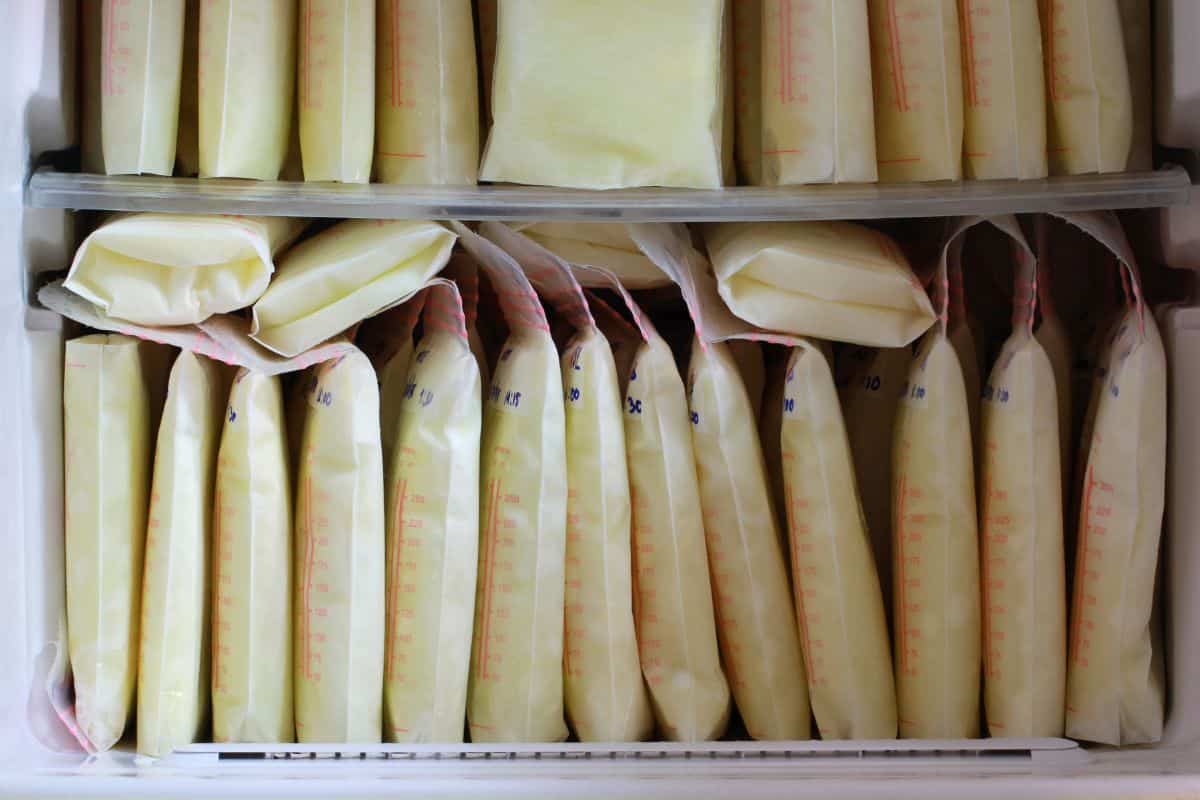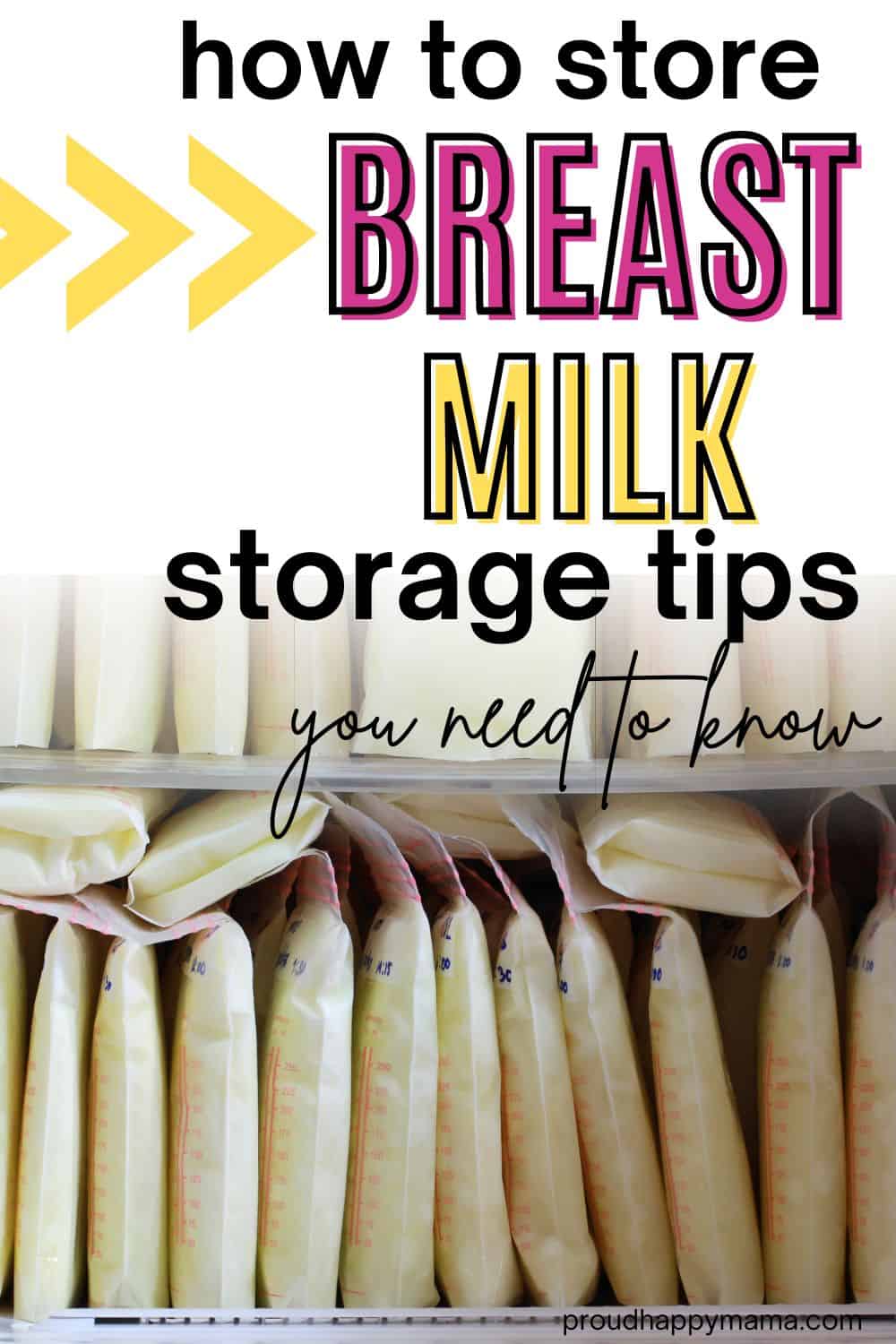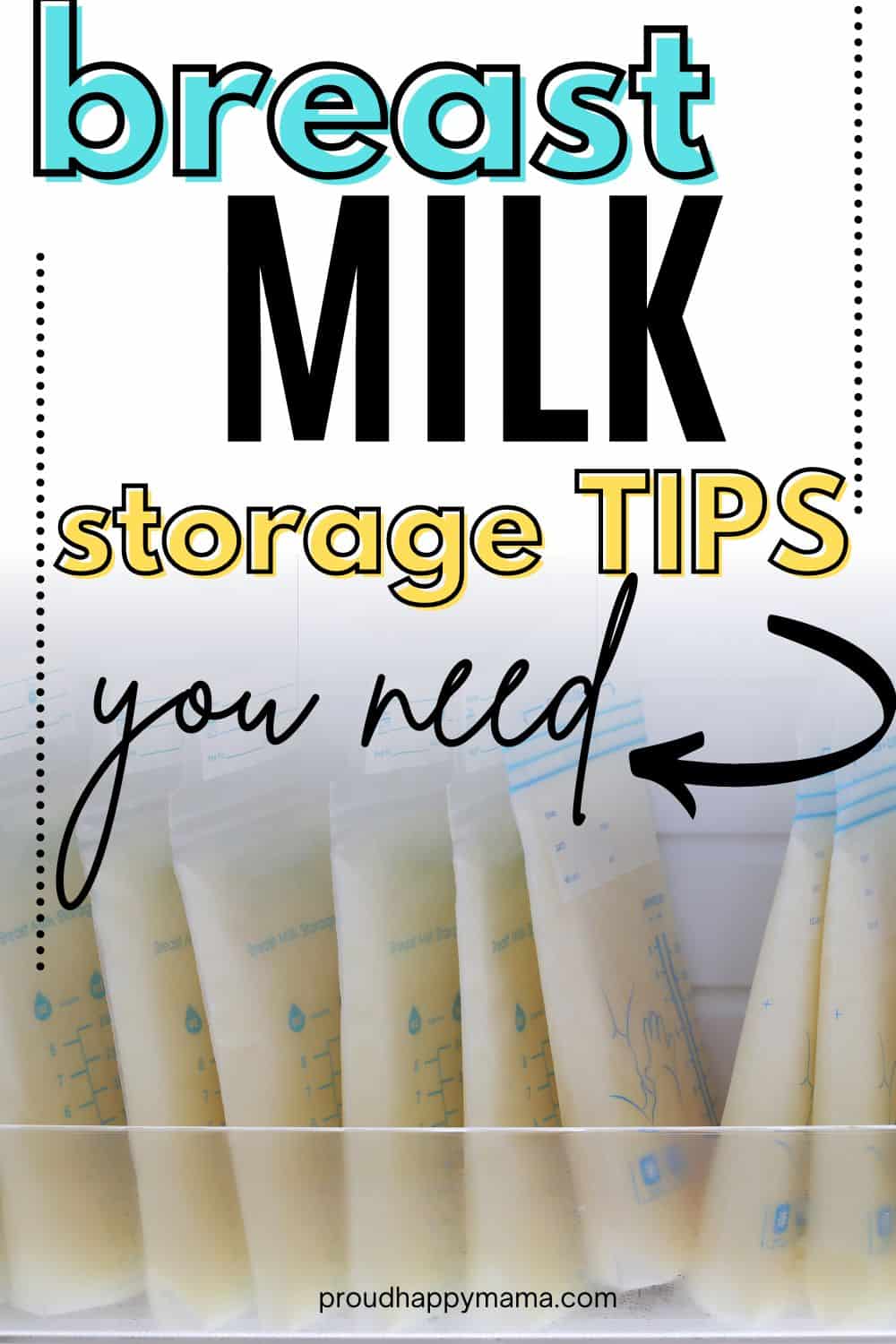How To Store Breast Milk
Learning how to store breast milk, including preparation techniques, can help to ensure the safety and quality of expressed breast milk for your baby’s health.
There is no denying that breast milk is a remarkable source of nourishment for infants, offering a perfect blend of nutrients, antibodies, and essential components crucial for their growth and development.
However, incorrect preparation and storage of human breast milk can lead to loss of its nutritional value as well as bacterial growth and spoilage that can compromise the health of your baby.
This is why proper storage and handling of breast milk is critical to ensure its safety, nutritional integrity, and freshness of breastmilk for your little one.
So, whether you’re a new mother seeking to build a stash of stored breast milk, a working parent returning to your job, or simply looking for tips to optimize the use of this precious resource, this guide will provide you with the knowledge and confidence you need for practical and safe breast milk storage.

Human Milk Storage Guidelines
When it comes to storing breast milk safely, it’s crucial to adhere to guidelines set by trusted organizations such as the Centers for Disease Control and Prevention. These guidelines serve as the gold standard for ensuring your breast milk remains safe for your baby.
Here’s a look at their recommendations:
| Storage Location and Temperatures | |||
| Type of Breast Milk | Countertop 77°F (25°C) or colder (room temperature) | Refrigerator 40°F (4°C) | Freezer 0°F (-18°C) or colder |
| Freshly Expressed or Pumped | Up to 4 Hours | Up to 4 Days | Within 6 months is best Up to 12 months is acceptable |
| Thawed, Previously Frozen | 1–2 Hours | Up to 1 Day (24 hours) | NEVER refreeze human milk after it has been thawed |
| Leftover from a Feeding (baby did not finish the bottle) | Use within 2 hours after the baby is finished feeding | ||
Difference between Fresh, Refrigerated, and Frozen Breast Milk
Just like breastfeeding, breast milk storage isn’t a one-size-fits-all process. It varies depending on your immediate needs and how long you plan to store the milk.
Here’s a breakdown of how to differentiate between fresh, refrigerated, and frozen breast milk:
Fresh Breast Milk
This is milk that has been expressed and is ready for immediate use. It can be kept at room temperature for a limited time up to 4 hours but should be used as soon as possible for optimal freshness.
Refrigerated Breast Milk
Breast milk that is stored in the refrigerator at a temperature of 32–39°F (0–4°C) for up to 4 days. It’s essential to store it in the back of the refrigerator, away from the door, to maintain a consistent temperature.
Frozen Breast Milk
If you don’t plan to use breast milk within the recommended time frame for refrigeration, freezing is a viable option. Breast milk can be frozen for an extended period, typically up to 6–12 months, depending on your freezer’s temperature and the type of storage containers used.
Factors Affecting Breast Milk Shelf Life
Several factors can influence the shelf life of breast milk. It’s essential to be aware of these factors to ensure that your stored breast milk remains safe and nutritious for your baby:
Temperature
The temperature at which breast milk is stored is critical. Higher temperatures can lead to the growth of harmful bacteria, while lower temperatures can affect the milk’s quality. Always follow the recommended storage temperatures for fresh, refrigerated, and frozen breast milk.
Sanitization
Properly sanitizing all equipment, including breast pump parts and storage containers, is crucial to prevent contamination. Failure to maintain cleanliness can lead to spoilage or bacterial growth.
Container Choice
The type of storage container you use matters. BPA-free, specifically designed breast milk storage bags or containers are ideal. These containers help preserve the milk’s quality and ensure it remains safe for your baby.
Freezer Quality
The quality and temperature of your freezer can impact the longevity of frozen breast milk. Ensure your freezer maintains a constant temperature of 0°F (-18°C) or lower to prevent the milk from thawing and refreezing, which can lead to freezer burn.
This guide on the best freezers for breast milk is a great guide if you’re looking for a new freezer for your breastmilk storage.
By understanding these breast milk storage guidelines, differentiating between storage methods, and considering the factors that affect shelf life, you can provide your baby with the highest quality and safest nutrition while optimizing your breastfeeding experience.
Storage Container Options
When it comes to storage containers for breast milk, there are two main options that you can choose from. Depending on how you plan to store your breast milk, room temperature, refrigerated, or frozen will also play a key role in which type of storage container you might need.
Breast Milk Storage Bottles
Milk storage bottles are specialized containers designed for the safe and hygienic storage of expressed breastmilk.
They are generally available in BPA-free plastic or glass; however, glass is less common.
They feature wide necks for easy pouring, airtight seals to prevent leaks and maintain milk freshness, and often compatibility with breast pumps for convenient direct pumping.
What’s great about them is that they are sturdy, reusable, and come in various sizes to accommodate varying feeding needs.
On the downside, they may take up more space in your refrigerator or freezer compared to storage bags.
Breast Milk Storage Bags
Milk storage bags are specialized, pouches designed for the secure and hygienic storage of expressed breast milk.
Whilst traditionally they are single use, there are now several reusable milk storage bag options available.
Typically made from food-grade, BPA-free materials, these bags come with pre-sterilized surfaces and are equipped with leak-resistant seals to prevent spills and contamination.
They often feature easy-to-read volume markings, which facilitate precise measurement of the stored breast milk.
Milk storage bags are particularly popular for their convenience and space-saving design, making them an excellent choice for mothers looking to create a freezer stash or for those needing to store breast milk for feeding when they are away from their infants.
If is important to note, that milk storage bags can be less durable than bottles, so they need to be handled carefully. They may also be less environmentally friendly if using single use milk storage bags.

Steps for Storing Breast Milk
Here are some critical steps to take when storing breast milk.
Before Expressing or Handling Breast Milk
Whether you’re choosing to express breast milk by hand or with a breast pump, before expressing or handling breast milk, it’s important to:
- Wash your hands thoroughly before handling your breasts and any equipment or use a hand sanitizer with at least 60% alcohol.
- Use a clean and sterilized container for collecting the milk. Minimize touching the inside of the storage container or bottle. Use a sterilized funnel if necessary to transfer milk.
- If using a breast pump, inspect and ensure the cleanliness of the pump, including tubing, replacing any moldy tubing immediately.
- For shared pump use, clean the pump dials, power switch, and countertop with a disinfectant wipe.
Fill Containers Carefully
When filling and sealing storage containers, it’s important to maintain a sterile environment and ensure proper sealing to preserve the quality of the breast milk.
Fill storage containers with breast milk, leaving some space at the top to allow for expansion when freezing. It’s typically recommended to leave about an inch of space to prevent leakage.
Seal Containers Securely
Use containers with airtight seals to prevent air from entering and compromising the milk’s quality. Ensure that lids or caps are screwed on tightly.
Label and Date Containers
Label each container with the date of expression. This helps you prioritize the use of older milk first, following the “first in, first out” principle.
I highly recommend investing in waterproof, non-toxic labels or markers designed for labeling baby items. These labels should not smudge or fade when exposed to moisture.
I also think it is very beneficial to note the volume of breast milk in each container. This information can be helpful for portion control and ensuring your baby receives the appropriate amount of milk during feedings.
Store Containers Properly
Place filled and sealed containers immediately into the refrigerator or freezer according to your storage preference.
Storage Tips
- Clearly label each container or bag with the date when the milk was expressed. This helps you use the oldest milk first (first in, first out) and ensures freshness.
- Ensure you follow temperature guidelines. Store freshly pumped milk at room temperature (77°F or 25°C) for up to four hours, in the refrigerator (32-39°F or 0-4°C) for up to four days, and in the freezer (0°F or -18°C) for up to six month to 12 months.
- Store expressed milk in small portions, typically 2-4 ounces (60-120 milliliters) per container or bag. This minimizes waste and allows you to thaw only what your baby needs for each feeding.
- If you won’t use freshly expressed breast milk within four days, freeze it promptly to preserve its quality.
- In the refrigerator and freezer, place milk containers at the back, where temperatures are more stable, rather than in the door. Storing milk in the door can cause temperature fluctuations caused by frequent door opening and closing, possibly impacting milk quality.
- Also leave about one inch of space at the top of the container as breast milk expands when freezing.
- If you provide breast milk to a childcare provider, label the container with the child’s name and discuss any specific labeling and storage requirements with them.
- While traveling, store breastmilk in an insulated cooler with frozen ice packs for up to 24 hours. At your destination, use the milk immediately, refrigerate it, or freeze it for future use.
Thawing and Using Stored Breast Milk
Thawing breast milk safely is crucial to preserve its nutritional value and ensure your baby’s health. Here are safe methods for thawing breast milk:
Refrigerator Thawing
This is the recommended and safest method for thawing breast milk. Simply remove the frozen breast milk container from the freezer and place it in the refrigerator. Thawing in the refrigerator is a gradual process that helps maintain the milk’s quality. Allow 12-24 hours for the milk to thaw completely in the fridge.
Warm Water Bath
If you need to thaw breast milk more quickly than the refrigerator method allows, you can use a warm water bath. Place the frozen breast milk container in a bowl of warm (not hot) water. Change the water periodically to maintain a consistent temperature. Be cautious not to submerge the container entirely, as this can compromise the seal and introduce contaminants.
Running Water
Another faster thawing method involves running cool water over the sealed breast milk container. The water should be at room temperature or slightly warmer, and you should continually adjust the flow to maintain a steady temperature. This method can thaw milk in a few hours.
Thawing in a Bottle Warmer
If you have a bottle warmer designed for breast milk or baby food, follow the manufacturer’s instructions to thaw the milk safely. These devices typically provide precise temperature control to prevent overheating.
Avoid Using A Microwave
Never use a microwave to thaw or heat breast milk.
Microwaving breast milk can lead to uneven heating, creating hot spots that can scald your baby’s mouth or throat.
Furthermore, microwaving can destroy essential nutrients in breast milk and alter its composition. To safely thaw or warm breast milk, opt for one of the methods mentioned above, such as refrigerator thawing, warm water bath, running water, or a bottle warmer designed for this purpose.
Testing Breast Milk for Freshness
It’s essential to ensure that thawed breast milk is safe for your baby to consume. Before serving stored breastmilk to your baby, I recommend doing the following steps:
- Smell Test: Before feeding, smell the thawed breast milk. Fresh breast milk should have a mild, slightly sweet odor. If it smells sour, rancid, or off in any way, it may have spoiled, and you should discard it.
- Visual Inspection: Examine the appearance of the milk. Fresh breast milk is typically white or bluish-white, with a creamy layer of fat at the top. If you notice any unusual changes in color, such as a green or pinkish tint, it may indicate spoilage.
- Taste Test (Optional): While not common, some parents choose to taste a small drop of thawed breast milk to ensure it hasn’t gone bad. Fresh breast milk should have a slightly sweet taste. If it tastes sour or unpleasant, it may not be suitable for your baby.
- Milk Temperature: Always check the temperature of the thawed breast milk before feeding. It should be lukewarm, similar to body temperature. Test it by placing a drop on your wrist. It should feel neither hot nor cold.
- Consistency: Swirl or gently shake the container to mix any separated milk layers, especially the fat layer. The milk should mix easily, and the consistency should be uniform.
If, after performing these checks, you have any doubts about the freshness or safety of the breast milk, it’s best to err on the side of caution and discard it.
Ensuring that your baby receives only fresh and safe breast milk is essential for their health and well-being.
Proper thawing methods and regular inspection of thawed milk can help you achieve this goal.
FAQs
Can you mix fresh and frozen breast milk?
Yes, you can mix fresh and frozen breast milk. Mixing fresh and frozen breast milk is safe and can be a convenient way to combine milk from different pumping sessions to create larger portions for feeding.
Ensure that both the fresh and frozen breast milk are at the same temperature before mixing. For example, if you have fresh breast milk that’s just been expressed, cool it in the refrigerator before combining it with frozen milk.
Gently swirl or shake the containers to mix the milk, taking care not to introduce any contaminants.
Remember to label the container with the date of the oldest milk, and use it within the recommended storage duration based on the oldest milk’s date.
How long does breast milk last at room temperature?
Freshly expressed or pumped breast milk can be safely stored at room temperature (77°F or 25°C) or colder for up to four hours. After this time, it’s advisable to either use the breast milk for feeding or refrigerate it to maintain its freshness.
Thawed breast milk, which has been previously frozen, should be used within 1-2 hours or stored in the refrigerator for up to one day, and it should never be refrozen after thawing.
Additionally, leftover breast milk from a feeding should be used within 2 hours after the baby has finished feeding.
How do you store freshly pumped breast milk?
Freshly pumped breast milk should be stored in clean and sterile breast milk storage containers, such as BPA-free plastic or glass bottles, or specialized breast milk storage bags. Ensure the container is tightly sealed to prevent leaks and contamination. Label the container with the date of expression and store it at the appropriate temperature: room temperature for up to 4 hours, in the refrigerator at 40°F (4°C) for up to 4 days, or in the freezer at 0°F (-18°C) or colder for up to 12 months.
Can I store breast milk in a bottle in the fridge?
Yes, you can store breast milk in a bottle in the refrigerator, but it’s advisable to use a clean and sterile breast milk storage container for more extended storage. If you use a bottle, make sure it has a tight-fitting cap or lid to maintain freshness and prevent contamination. Label the container with the date of expression and store it at 40°F (4°C) or lower for up to 4 days.
Can I put breast milk back in the fridge after the baby drinks from it?
No, it is not safe to put breast milk back in the fridge after a baby has started drinking from the bottle. Once breast milk has been brought to room temperature and the baby has begun feeding from it, bacteria from the baby’s mouth can enter the milk, increasing the risk of contamination. It’s safer to discard any remaining milk after a feeding to ensure the baby’s health and milk quality.
Related Feeding Guides
Final Thoughts
Breast milk storage is a crucial aspect of breastfeeding for both convenience and the well-being of your baby.
The good news is that there are several ways that you can store breast milk to ensure that you always have it on hand when needed.
From storing at room temperature to refrigeration to freezing your breast milk, the key is to ensure that you follow the correct breastmilk storage guidelines, choose a suitable container, and label your containers clearly.
By following recommended guidelines and practicing proper hygiene, parents and caregivers can provide their babies with the many benefits of breast milk while ensuring its safety and quality.

